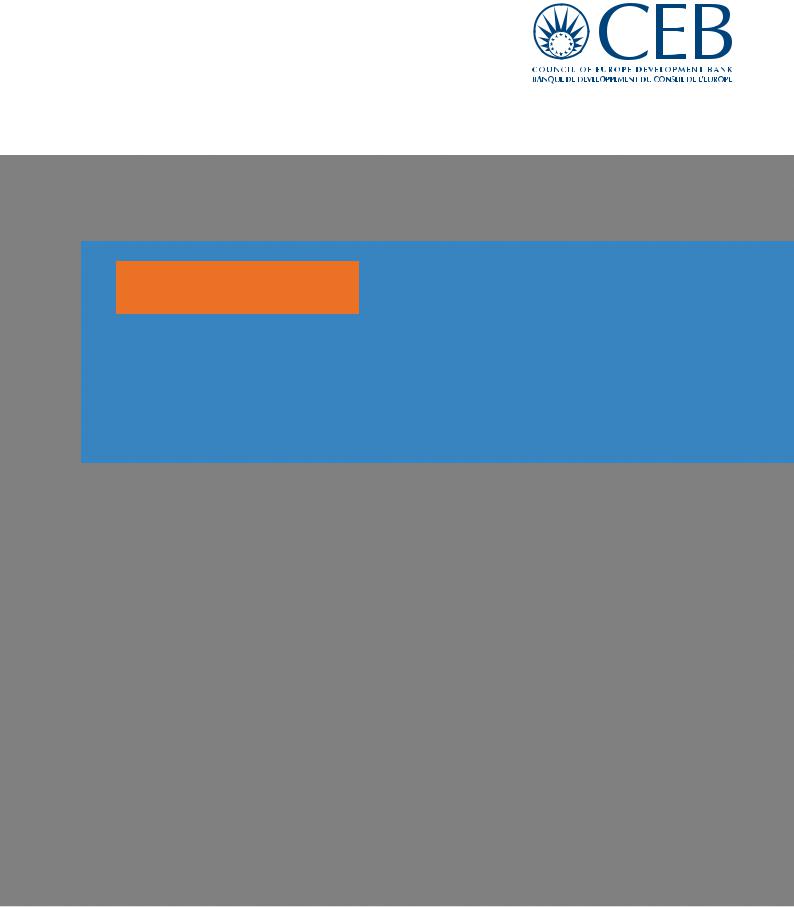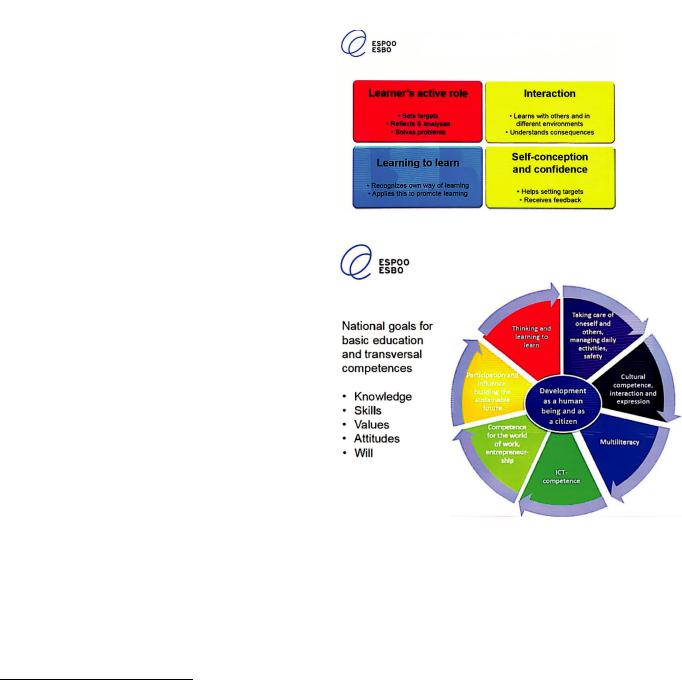
- •Executive Summary
- •Introduction
- •City Context
- •Education Context
- •Conceptual Framework for Effective Learning Environments
- •Main Findings
- •Main Conclusions
- •Recommendations
- •Annex 1 School Selection and Data Collection Instruments
- •Annex 2 Characteristics of School Design
- •Annex 3 Use of Learning Environments
- •Annex 4 Technical Characteristics of Schools Visited
- •Annex 5 Data Collection Results
- •Annex 7 Agenda of Meetings

/+*-&/,(!.*0,*1
(*/441!$,70.3!)3+!',)6303.!%3906432,387!03! 8/,!#08;!4-!%7544"!&031)3+
)*(*-'*.!$"#%

School Design and Learning Environments
in the City of Espoo, Finland
December 2018
Disclaimer
The findings, interpretations, and conclusions expressed here are those of the authors and do not necessarily reflect those of the Organs of the Council of Europe Development Bank (CEB), who cannot guarantee the accuracy of the data included in this paper.
The designations employed and the presentation of the material in this paper do not imply the expression of any opinion whatsoever on the part of the CEB concerning the legal status of any country, territory, city or area, or of its authorities, or concerning the delimitation of its frontiers or boundaries.
The working paper is printed in this form to communicate the result of an analytical work with the objective of generating further discussions on the issue.
Acknowledgements
This paper was prepared by Yael Duthilleul (Education Technical Advisor, Directorate for Technical Assessment & Monitoring) in collaboration with Alastair Blyth (Consultant), Wesley Imms (Consultant) and Kristina Maslauskaite (Research Analyst, Directorate for Technical Assessment & Monitoring) and supervised by Monica Brezzi (Director, Directorate for Technical Assessment & Monitoring). Mr Tigran Shmis, Senior Education Specialist at the World Bank provided useful feedback to an earlier version of this paper. Comments from colleagues in the Directorate for Loans & Social Development are kindly acknowledged. The support received from Espoo officials to complete this review and the feedback provided to earlier versions are gratefully acknowledged.
Please cite this publication as:
Duthilleul, Y., Blyth, A., Imms, W. and Maslauskaite, K. (2018). Design and Learning Environments in the City of Espoo, Finland. Thematic Reviews Series. Council of Europe Development Bank, Paris.
https://coebank.org/media/documents/ School_Design_and_Learning_Environments_in_the_City_of_Espoo_Finland.pdf
Cover: © CEB
School Design and Learning Environments |
|
in the City of Espoo, Finland |
|
December 2018 |
3 |
Table of Contents
Executive Summary |
4 |
|
Introduction |
5 |
|
City Context |
6 |
|
Education Context |
6 |
|
Conceptual Framework for Effective Learning Environments |
8 |
|
Main Findings |
11 |
|
Main Conclusions |
17 |
|
Recommendations |
19 |
|
Annex 1 School Selection and Data Collection Instruments |
23 |
|
Annex 2 Characteristics of School Design |
30 |
|
Annex 3 Use of Learning Environments |
36 |
|
Annex 4 |
Technical Characteristics of Schools Visited |
39 |
Annex 5 |
Data Collection Results |
56 |
Annex 6 |
Results from the SDU Survey (Imms et al, 2017) |
58 |
Annex 7 |
Agenda of Meetings |
62 |

|
School Design and Learning Environments |
|
in the City of Espoo, Finland |
4 |
December 2018 |
Executive Summary
This report presents the main findings and recommendations resulting from a review of education infrastructure investments in the city of Espoo, Finland, carried out by the CEB’s Technical Assessment & Monitoring Directorate. The objective of the review was to examine the links between school design and learning environments. The report provides Espoo officials with recommendations for enhancing the effectiveness of the education investment and identifies good practices that could be shared with other countries.
The City of Espoo and the Finnish education system are internationally recognised as top performers for learning outcomes and one of the most equitable. However, rapid population growth, increasing numbers of children and foreign-language residents, and general tightening of the public budget pose challenges to service delivery just at a time when education infrastructure is expected to adapt to new learning curricula.
Notwithstanding these challenges, the commitment to education remains very high on the part of all the stakeholders met in the city of Espoo. This commitment is reflected in the strategy for the City, the continuous financial support provided to the sector over the years, and the deep value and trust placed in their highly educated teachers. The eight schools visited by the review team already reflect some elements of the vision promoted by the new curriculum introduced in 2017, including the presence of differently sized learning spaces, heightened transparency and increased flexibility. The average learning space per child tends to be more generous than in other countries, given the use of spaces such as corridors and common areas for learning activities.
The review team identified a series of key themes to encourage further discussion and exploration by Espoo teachers and city officials in their search for effective strategies to guide investments in the education sector. These include:
the need to find the right balance between cost-effectiveness and the promotion of effective learning environments;
the value of systematically involving the school community in the design process;
the importance of providing the necessary support for teachers to transition into new learning environments, by developing and implementing an Effective Spatial Professional Development programme.
Ultimately, the effectiveness of any investment depends on how well it is used. In this regard, international research is unanimous in identifying teachers as the factor that correlates most strongly with student achievement. Thus, as part of any build, investing in teachers’ effective use of spaces must be a priority and an important component in the budgeting process.
School Design and Learning Environments |
|
in the City of Espoo, Finland |
|
December 2018 |
5 |
Introduction
This report presents the main findings and recommendations resulting from a review of education infrastructure investments in the City of Espoo, Finland. Part of the 2016-2019 investments are being cofinanced by an €80 million loan provided by the Council of Europe Development Bank (CEB). The review was carried out by the Technical Assessment and Monitoring Department (TAM) of the CEB as part of its regular technical monitoring review. In agreement with the education officials of the City of Espoo, the objectives were expanded to have a more in-depth examination of the links between school design and learning environments. More specifically, the review sought (i) to assess how a selection of Espoo’s schools compared to one another in terms of current international trends in school design and (ii) to explore how the selected facilities were performing pedagogically, i.e. the way in which the buildings service the schools’ original educational vision, and the way teachers and students utilise the opportunities provided by the building design to maximise student learning.
The purposes of this review were to provide Espoo officials with recommendations on how to enhance the effectiveness of the education investment carried out and for the CEB to identify effective practices that could be shared with other member countries. A team of experts led by Ms Yael Duthilleul, Education Advisor of the CEB, and comprising Mr Alastair Blyth (Architect), Prof Wes Imms, (Education specialist) and Ms Kristina Maslauskaite (Research Analyst of the CEB) visited Espoo the week of May 1418, 2018. Mr Tigran Shmis (Senior Education Specialist at the World Bank) joined the review team as part of a CEB – World Bank professional exchange programme.
Prior to the visit, the team undertook a review of existing policy documents, studies and statistics on the City; selected the schools to visit; designed specific survey instruments to collect background information on the selected school buildings, their students and teachers; and organised a series of meetings with City officials and school staff. All visits and data collection efforts were organised thanks to the support of the International Affairs Unit from the Education and Cultural Services of Espoo. Information on the schools selected and the instruments designed for data collection purposes can be found in Annex 1.
The team visited eight schools in Espoo. Four of them had benefitted from the CEB’s loan (three comprehensive schools and one day-care centre). The three schools selected were the only ones from the proposed investment plan that had been completed at the time of the visit. The daycare centre was selected for its proximity to one of the schools to be visited and its location in a highly socially diverse area. Total investments costs were not a criterion. In addition, the review team proposed to visit two other comprehensive schools which had been built previously and which had been recognised internationally for the quality of their design. The City also proposed to add two other schools (a primary school and an upper secondary school) that reflected their search for new cost-effective models for the delivery of school services. It must be noted that the data collection exercise focused on the six schools identified by the review team and not on the additional two, subsequently added to the agenda, on City Official’s recommendation. For this reason, some sections will occasionally refer to eight schools. However, most of the data analysis was largely restricted to the six selected schools.
During the visit, the review team met with school principals, teachers and students from the selected schools as well as with officials from the Education, Finance and Premises Department and with the Deputy Mayor, all of whom provided extensive information on the current status of education in the City and the challenges ahead. Annex 7 presents the agenda for the week.
The report starts with a brief introduction to the City and its education context, followed by a presentation of the conceptual framework developed to respond to the key objectives of the review. The main findings make up the core of the report, which concludes with a set of recommendations.

|
School Design and Learning Environments |
|
in the City of Espoo, Finland |
6 |
December 2018 |
City Context
Growing Population and Wealth, Economic and Social Challenges
Espoo is the second largest city in Finland with a population of 275 000 (or 5% of the national population). Espoo belongs to Finland’s most populous Uusimaa region, which covers only 3% of Finland’s territory, but is home to 30% of its inhabitants and generates almost 40% of its national GDP1. Since 1950, the population of the entire Helsinki area has more than doubled, and that of Espoo has increased tenfold because of the Great Migration from rural areas to cities2. Espoo is a young and increasingly diverse city: 20% of the city’s overall population is under 15 years of age and 4.8% of the population was born in another country (“New Finns”), including 20% of the children in early education. The share of foreignlanguage population of working age in Espoo is forecast to represent 30% by 2030. It is a highly welleducated city with 50% of the population holding a university degree. The city’s population has been increasing by an average of 4 500 new residents annually (new-borns and immigrants).
Fast population growth, an ageing population and a simultaneous increase in the number of children and foreign-language residents are leading to growing service needs and challenging service production and delivery. The monetary scale of the investment programme is unprecedented. The economic operating environment, sustainable development, digitalisation, urbanisation, ageing, replacement of jobs lost in the technology industry and the integration of immigrants are great challenges for Espoo. The city’s economy is also tightened by the tax-based equalisation between municipalities and population growth that is stronger than the growth in tax revenue. In the past, challenges have been resolved with the help of economic growth, but after the financial and euro crisis, this is uncertain. The general consensus is that growth will be slow for a long time, development needs will have to be prioritised and operations streamlined in a responsible manner (The Espoo Story, 2017).
Within this challenging context, education investments remain a priority. Almost half of the City’s budget (43%) was allocated to education in 2017. However, sustained investments come with attention paid to making more efficient use of resources. Espoo’s officials are looking for options to better respond to this objective by experimenting with alternative school models. The “school-as-a- service” model (e.g. two high-schools share laboratories, sport facilities and leisure areas with Aalto University and a “module-prefabricated model” elementary school) are evidence of these efforts. Both models were visited by the review team.
Education Context
Increasing Diversity, Deteriorating Infrastructure, Declining PISA Scores
Finland gained international recognition as the top performer and one of the most equitable systems in the world according to the Programme for International Student Assessment (PISA) from the very start of the Programme in 2000. Nonetheless, its performance has been declining since 2006, even if it remains the best performing country overall in Europe. This drop, as well as the increase in the number of low performers from 7% to 12%, is being taken seriously by government officials who have called for strong action and the involvement of all education stakeholders in the process of ensuring the system regains its positioning.
The education sector in Finland, in general, is facing several challenges. The continuous increase in the number of students enrolled, combined with deteriorating physical infrastructure, suffering from mould contamination, bring pressure to increase capacity, improve educational infrastructure, and develop measures to facilitate integration. Because of the problems related to air quality and mould in old school buildings approximately 3 000 pupils in Espoo are currently studying in temporary school buildings where they may spend 4 to 5 years until their new school is completed.
1European Commission (2018) Helsinki-Uusimaa Region [Online] Available at: https://ec.europa.eu/growth/tools- databases/regional-innovation-monitor/base-profile/helsinki-uusimaa/helsinki-uusimaa-region [Accessed on 27 February 2018]
2Espoo City (2017) The Espoo Story [Online] p.1 Available at: http://www.espoo.fi/download/noname/%7B00F4B1D2-BB41- 4301-91C9-727A8E8C15C3%7D/98265 [Accessed on 27 February 2018]

School Design and Learning Environments |
|
in the City of Espoo, Finland |
|
December 2018 |
7 |
New Curricula and Vision for Learning, Education as a Priority, High Value and Trust in Teachers
The new national core curriculum and local3 curricula that were introduced between 2015 and 2017 for all education levels are one of the responses to this call for action to improve results. The new curriculum reflects a new, inspiring and visionary conception of learning that promotes autonomy in the learning process. It is based on the understanding that learning takes place in interaction with other students, teachers and communities, and recognises the importance of fostering multidisciplinary thinking. Multidisciplinary learning modules and cross-curricular activities are expected to take place at least one week per year. It reflects a shift from “what” to learn to “how” to learn and places students centre stage. Figures 1 and 2 below present the key elements of the new basic education curriculum.
Learning is thought to take place not just in a |
Figure 1: Conception of Learning |
|
classroom but in the whole school and surrounding |
|
environment. This new conception of learning has a |
|
direct impact on the conception of the physical |
|
space designed for learning, as learning can take |
|
place anywhere and is not just confined to the |
|
classroom. Major investments in education |
|
infrastructure are on-going to renovate and expand |
|
schools to meet the demands of an increasing and |
|
more diverse population and to respond to this new |
|
vision of learning. Further work is also needed to |
|
promote a new working culture, methods and |
|
pedagogy and to promote teacher co-operation. |
Figure 2: Rethinking Competences |
Education remains a priority for Finnish society, as |
|
reflected in the political commitment of elected |
|
officials, who put education first and allocate the |
|
necessary resources for its development. To this |
|
shared agreement on the importance of education |
|
is added the great pride that Finnish society has in |
|
its teachers. Teachers are respected and valued |
|
professionals, trusted by society. It is the best |
|
students who are selected for teachers’ education |
|
programmes. School teachers are also required (and |
|
have been for a long time) to complete a masters |
|
level of education. |
|
Education in Espoo
Finland’s education system is renowned worldwide for its achievements both in absolute terms and in terms of homogeneity of performance in and between schools4. Espoo’s education results are some of the best in Finland. The city has been recognised as a UNESCO Learning City since 2013 and was given the Educating Cities Award of Living Together in Cities in 20165. The Espoo city strategy for the years 2017-2021 sets out the objective for Espoo to have the best learning results in Finland and at the same time to prevent inequality between schools so that “every parent can trust that the local school provides quality education”.
3Local curricula are developed under the framework of the national core curriculum. As providers of education services, individual municipalities decide on how their curricula should be implemented on the basis of their local priorities.
4Bastos, R., M., B. (2017) The Surprising Success of the Finnish Educational System in a Global Scenario of Commodified Education [Online] Available at: http://www.scielo.br/scielo.php?pid=S1413-24782017000300802&script=sci_arttext&tlng=en [Accessed on 27 February 2018]
5Espoo City (2017) Espoo as a Place to Study [Online] Available at: https://ec.europa.eu/esf/transnationality/filedepot_download/1249/1466 [Accessed on 27 February 2018]
